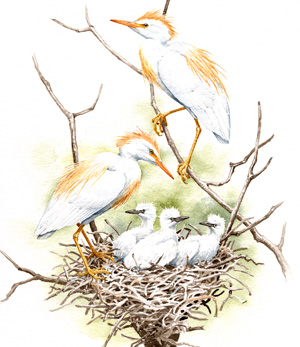Find a Bird
Cattle Egret
Bubulcus ibis

Very local, trend not established
“Our quick beaks pincer them, one and one, / those crisps of winnow, fats of air, / the pick of chirrup – we haggle them down / full of plea, fizz, cark and stridulation, / our white plumes riffled by scads going spare.” – Les Murray, “Cattle Egret”
Cattle Egrets are thought to have arrived in North America from the floodplains of Africa. When their native landscape became wet and flooded, they would eat their fill of fish and frogs. When the water dried up, the adaptable birds learned to follow the large ruminants (mainly African Buffalo) of the region in order to snap up the insects that the beefy beasts flushed. Over time such agricultural practices like irrigation and livestock grazing have been beneficial to the Cattle Egret, and they have expanded worldwide. These warm-weather birds may be pushing the envelope, however, in their efforts to colonize Massachusetts.
Historic Status
The first Cattle Egret positively identified in Massachusetts appeared in Wayland on April 23, 1952. Unlike those of several other heron and egret species, the arrival of the Cattle Egret was not one by a species on the edge of its range. This species had already made a transoceanic journey from Africa to South America, and then spread northward after colonizing the southern United States. Cattle Egrets became annual visitors to Massachusetts by the late 1950s, and from May 5 to 17, 1964, 155 Cattle Egrets were recorded in the state (Petersen & Meservey 2003).
Atlas 1 Distribution
Having come such a long way in such a short time, these vigorous Old World birds unsurprisingly wasted no time in spreading through Massachusetts. As it happened, however, their presence during Atlas 1 was rather limited. Two of the largest and most active heronries at the time, Clark’s Island and House Island, were the only places in the Commonwealth were Cattle Egrets were found nesting. At that time Cattle Egrets were also breeding inland in fresh water on Lake Champlain in Vermont, but no such inland records were ever reported in the Bay State.
Atlas 2 Distribution and Change
With the abandonment of the House Island and Clark’s Island rookeries, Cattle Egrets made a full-scale retreat in 1982 to a single location, Eagle Island off the coast of Essex County (Petersen & Meservey 2003). The species nested there during the Atlas 2 field season in 2008, but it was nowhere else to be found in the Bay State during Atlas 2 breeding seasons. Though the future is uncertain, the brief era of nesting Cattle Egrets in Massachusetts could be drawing to a close.
Atlas 1 Map

Atlas 2 Map

Atlas Change Map

Ecoregion Data
Atlas 1 | Atlas 2 | Change | ||||||
Ecoregion | # Blocks | % Blocks | % of Range | # Blocks | % Blocks | % of Range | Change in # Blocks | Change in % Blocks |
Taconic Mountains | 0 | 0.0 | 0.0 | 0 | 0.0 | 0.0 | 0 | 0.0 |
Marble Valleys/Housatonic Valley | 0 | 0.0 | 0.0 | 0 | 0.0 | 0.0 | 0 | 0.0 |
Berkshire Highlands | 0 | 0.0 | 0.0 | 0 | 0.0 | 0.0 | 0 | 0.0 |
Lower Berkshire Hills | 0 | 0.0 | 0.0 | 0 | 0.0 | 0.0 | 0 | 0.0 |
Vermont Piedmont | 0 | 0.0 | 0.0 | 0 | 0.0 | 0.0 | 0 | 0.0 |
Berkshire Transition | 0 | 0.0 | 0.0 | 0 | 0.0 | 0.0 | 0 | 0.0 |
Connecticut River Valley | 0 | 0.0 | 0.0 | 0 | 0.0 | 0.0 | 0 | 0.0 |
Worcester Plateau | 0 | 0.0 | 0.0 | 0 | 0.0 | 0.0 | 0 | 0.0 |
Lower Worcester Plateau | 0 | 0.0 | 0.0 | 0 | 0.0 | 0.0 | 0 | 0.0 |
S. New England Coastal Plains and Hills | 2 | 0.7 | 100.0 | 0 | 0.0 | 0.0 | -2 | -0.9 |
Boston Basin | 0 | 0.0 | 0.0 | 1 | 1.8 | 100.0 | 1 | 1.8 |
Bristol and Narragansett Lowlands | 0 | 0.0 | 0.0 | 0 | 0.0 | 0.0 | 0 | 0.0 |
Cape Cod and Islands | 0 | 0.0 | 0.0 | 0 | 0.0 | 0.0 | 0 | 0.0 |
Statewide Total | 2 | 0.2 | 100.0 | 1 | 0.1 | 100.0 | -1 | -0.1 |
Notes
Cattle Egrets show significant decreasing Breeding Bird Survey trends in the New England/mid-Atlantic and the eastern US regions.



